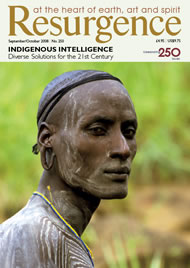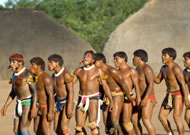“BIODIVERSITY ALSO incorporates human cultural diversity, which can be affected by the same drivers as biodiversity, and which has impacts on the diversity of genes, other species, and ecosystems.” Even a decade ago, one would have hardly expected to see a statement like this one in an official United Nations document, such as the UN Environment Programme (UNEP)’s flagship report, Global Environment Outlook. Back then, academics and a few others had just begun to focus on the idea that the diversity of life on Earth is diversity in both Nature and culture, and that biodiversity and cultural diversity (including linguistic diversity) are intimately, indeed inextricably, linked – so much so, that they should be thought of as a unified whole, ‘biocultural diversity’. There was also an emerging concern that the world’s biodiversity and cultural diversity are severely under threat by many of the same global forces. Yet, in most fields of enquiry, policy and action, ‘Nature’ and ‘culture’ were still treated as separate categories, and few if any connections were made between conserving biodiversity and supporting the diversity of cultures and languages.
In a way, it is ironic that such an integrated concept of life in Nature and culture should be seen as a new idea. Many cultures around the globe, past and present, conceive of people and their natural environment as a single whole, in which humans are part of, not separate from, the natural world. In this sense, to posit the idea of biocultural diversity in the scientific literature was to rediscover a view that had become obscured through centuries of Western civilisation: a civilisation built on the misconceived and ultimately ruinous belief in humans’ separateness from Nature and dominion over it.
In recent times our understanding of the interdependencies between cultural and biological diversity has advanced at many levels. Researchers have produced global and regional mapping of biodiversity and cultural diversity, revealing significant overlaps in distribution, and have analysed the factors accounting for the striking geographic patterns that can be observed. Others are at work to develop integrated indicators: quantitative tools that will allow us to measure the state and trends of biocultural diversity as a whole, so that we can know how biocultural diversity is responding to the threats it is
facing. Ethnographic and ethnobiological research continues to uncover the rich details of local cultures’ interactions with their biodiverse surroundings, as well as the circumstances that disrupt those interactions; in so doing, it illuminates the myriad local processes that, cumulatively, contribute to global biocultural diversity – or to the loss thereof.
As the quote at the beginning of this article shows, international organisations have begun to pay attention. UNEP defines biodiversity as inclusive of cultural diversity. Understanding the links between cultural and biological diversity and how to sustain and strengthen them is now part of the programme of work of the International Union for the Conservation of Nature (IUCN). It is also a focus within UNESCO, which has recently passed declarations and conventions related to cultural diversity. In turn, the Convention on Biological Diversity (CBD) – the main international instrument for the protection of biodiversity – has within its purview the protection and promotion of “knowledge, innovations and practices of Indigenous and local communities embodying traditional lifestyles relevant for the conservation and sustainable use of biological diversity”; in this capacity, it is seeking to develop indicators of the state and trends of Indigenous knowledge and languages.
Perhaps most significantly, after many years of efforts and negotiations involving Indigenous organisations from all over the world, in 2007 the UN passed the Declaration on the Rights of Indigenous Peoples, which, although not legally binding, enshrines fundamental and morally authoritative principles about the links between
Indigenous peoples and their lands, cultures and languages.
Recently, Terralingua, a small international NGO, co-organised a symposium on ‘Sustaining Cultural and Biological Diversity in a Rapidly Changing World: Lessons for Global Policy’. The purpose was to provide an opportunity to assess the current state of our knowledge about biocultural diversity and to explore ways in which it can be sustained and supported at different scales, from the local to the global, and through a variety of means, from action on the ground to policy at the international level. Over 350 people from all continents, including social and natural scientists, conservationists, Indigenous researchers and activists, funders, and members of non-governmental organisations and international organisations, gathered and exchanged ideas during the symposium. One of the key outcomes is the formulation of policy inputs for several international processes, particularly the World Conservation Congress in Barcelona, Spain this autumn. The goal is to push for integrative policies that will incorporate the ‘inextricable link’ between conserving biodiversity and maintaining the vitality and resilience of the world’s diverse cultures and languages.
Such policies would, for example, favour conservation activities which are initiated and directed by local communities – for instance the kinds of global initiatives known as Indigenous
Community Conserved Areas (ICCAs). These are commonly spontaneous activities conducted by local communities, often for generations, based on local knowledge, beliefs and practices about the use and management of local ecosystems and biodiversity. But a fully fledged biocultural perspective will necessarily require an extra step. That is, policy should not be limited to fostering the direct conservation activities carried out by ICCAs and similar initiatives, but should support the overall context in which such activities occur: the social institutions, worldviews and cultural traditions, language and knowledge transmission, subsistence practices, and land tenure and other rights, which make communities strong and able to nurture the environments that nurture them.
This may sound like a tall order, but the alternative is failing in our efforts to sustain life on the planet. A survey recently completed by Terralingua reviewed nearly fifty initiatives from all over the world that take an integrative biocultural approach to sustaining cultures and biodiversity. From community protection of forests and sacred sites, to recovery of traditional crops, medicinal plants and wild species and the related knowledge and values, to strengthening local languages as repositories of such knowledge and values, to using traditional knowledge for land use planning, demarcation of traditional territories, and the development of community ‘life plans’, educational programmes, and economic opportunities, the diversity of solutions adopted in these initiatives is as remarkable as the diversity of the people and peoples involved.
This diversity of solutions itself offers the most poignant lesson to be learned from a biocultural perspective: that cultural diversity is not a matter of superficial, if aesthetically pleasing, exotic flavours; it is the deep reflection of human creativity and inventiveness put to the service of enduring issues of adaptation – and, increasingly, of pressing issues of planetary survival.







